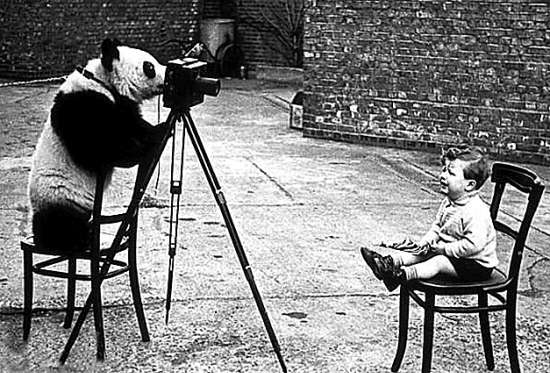On September 1, 2015 the world marked in many different ways the 706 anniversary of the end of World War II. During this momentous occasion, several stories of the giant pandas that brought hope and consolation to war-torn people came to mind London dents were putting the finishing touches on their preparations for Christmas 1944 when the London zoological park issued the sad announcement that the giant panda Ming, who had lived through the war years with the British people, had breathed her last breath.
Immediately afterwards a sentimental article in memory of Ming was published in “The London Times” saying that she was similar to an exquisite toy bear and had brought joy and delight to the British people in times of great hardships.
From 1940-41, German air raids bombarded London and sirens pierced the night air alongside deafening explosions. However, Ming continued on with daily life, unfazed. Chosen as a symbol of peace, Ming appeared in several anti Nazi feature films shot by the BBC and American military media. Sadly she passed away before the arrival of peace only a few months later.
According to Dr. Hu Jinchu, an expert in giant panda research, Ming was one of the twelve giant pandas captured by a British man, Floyd Tangier Smith. In the 1930-40s pandas were abundant in the wild, and Smith earned the nickname Panda King after capturing more wild pandas than anyone else during this era. Dr. Hu still has a photo that was taken in 1938 of the four pandas-Ming, Tang, Song (named after the ancient Chinese dynasties) and Pandora. Smith caught the first three while Frank Dickenson purchased Pandora from Guan county, today’s city of Dujiangyan. Frank Dickenson was a biology professor at the West China Union University (WCUU), a university founded in 1903 by joint foreign efforts at Huaxiba (today’s Sichuan University) in Chengdu.
The four giant pandas stayed in captivity for some time at the Canadian School built on the WCUU campus, making it figuratively the first giant panda base in the world.This first giant panda base had another two temporary members in 1941 during the fierce fighting of World War D. At that time, Soong May-ling, wife of Chiang Kai-shek (Chairman of the National Military Council of China), and her sister Soong Ai-ling, decided to present two giant pandas to the United States as a gesture of gratitude for the efforts made in China by the Chinese Refugees Relief Association of America.
The government officials in Chengdu asked Dr. Graham, a WCUU professor, for help to find two pandas. Graham went to Wenchuan and hired 70 local hunters, who brought 40 of their dogs. The hunters were divided into seven teams and each team provided Dr. Graham with a giant panda, either captured or purchased. Out of the seven, the two chosen pandas stayed in Graham’s backyard for over a month.
John tie Van of the Bronx Zoo in New York was sent to China to retrieve the pandas. He travelled by plane, ship, train and car, going across New Zealand, Australia, Singapore, Thailand and Burma, and finally to Chongqing.Upon his arrival to Chongqing, he was amazed that the city remained untouched by the war.When he reached Chengdu, his journey totaled 34,868km, nearly half the circle around the earth.
After receiving the two giant pandas from Dr.Graham, the pandas and John tie Van flew from Chengdu to Chongqing via a Douglas plane.When they arrived in Chongqing they were greeted by a mass of reporters taking pictures of them. After going through the airport customs procedures, he crossed the liver by boat with the giant pandas, and then hired a few laborers to carry the heavy encaged animals from the river to the highway that was up many flights of ascending stairs, and then to the specified destination in Chongqing. In the days following because the locals had never seen giant pandas, there were so many visitors where the pandas were kept that the police had to be sent to keep order.
Fortunately during their brief time in Chongqing no bombs were dropped from the Japanese air bombers.On November 9, the Guomingtang (Nationalist Party) Government held a grand presentation ceremony in Chongqing Gardens. Those in audience included Chiang Kai-shek, his wife Soong May-ling, his sister-in-law Soong Ai-ling, foreign and Chinese reporters. Five days later on November 14, the giant pandas, bamboo branches (their food) and John tie Van joined other passengers on a plane from Chongqing to Kowloon, Hong Kong. After a one-night layover, they flew to the Philippines.Shortly after the plane took off there were explosions at the airport-then it was taken over by the Japanese.
Upon their arrival in the Philippines the giant pandas began panting very hard due to the equatorial hot weather. John tie Van was worried for both their health and safety. War was imminent on the Pacific Ocean. On November 17, ten days before the attack on Pearl Harbor by the Japanese, the ship with the two pandas on board left the Philippines capital, Manda. In order to evade being spotted
By Japanese planes, it had to head southwards, traveling across the equator and then northwards. It is astounding that the pandas survived the suffocating heat through their trip, as their is adapted for cold-temperature ecosystems.When they were still a far distance h:ore Hawaii,the Pacific War broke out. The chiefmate of the ship became highly anxious that the black and white fur of the pandas would give them away, and attempted to paint them in false colors after painting the ship in camouflage, though John argued with him about the necessity of such measures. Despite the immense challenges, the pandas and John tie Van arrived at San Francisco safe and sound.
The American people showed tremendous enthusiasm towards this pair of giant pandas that
had been tempered by nature and by war, and named them Pantile and Panda.


























































































